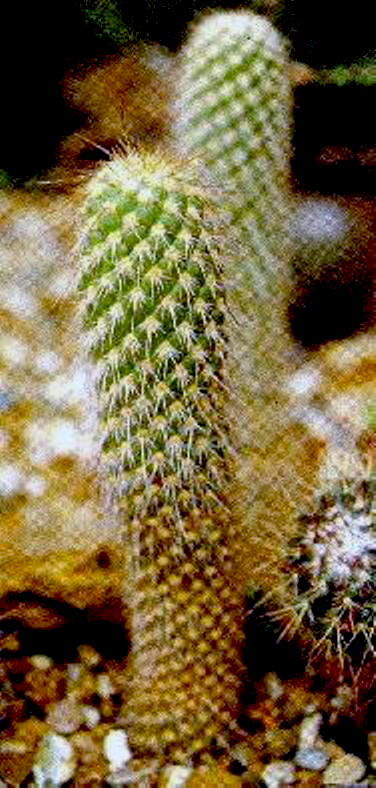By Marina Welham
![]()
Featured image: AI-generated text-to-image of Opuntia Pachypus in flower.

Photo of Opuntia pachypusfrom CACTI by Innes/Glass
Those who often dismiss opuntias as nothing but prickly, uninteresting plants, might be overlooking some very interesting species not the least of which is Opuntia pachypus.
This cactus was first described by Karl Schumann in 1904. For quite a while it was rather rare in collections and still is not all that readily obtainable … but well worth searching for.
O. pachypus. is a columnar cactus (mine is now nearly 4 ft. tall) and while thought to be usually a solitary plant (meaning it doesn’t branch), sometimes it will branch from the base as mine has done this year. The body is never more than about 3-1/4 in. thick so even a small greenhouse has room to accommodate it.
I have found this cactus does best in a tub or other type of free root run container although you can also grow it in a pot. It is slow growing but in my experience speed of growth seems to increase the older and taller the plant becomes.
A native of the Chosica Valley of Peru, the body of the plant is bright green and the closely spaced areoles are yellow and armed with thin yellowish spines. Cristate forms have been seen occasionally.
Some say cuttings are very difficult to root. I have had the opposite experience having rooted many cuttings with no trouble at all.
One interesting experience I’ve had with this Opuntia is that after being kept quite dry in my cold greenhouse (min. 45F) during winter months I found the plant bent over at a 45 degree angle and I had to tie it to a support to stand it up straight. Shortly after water was once again applied in spring, the plant straightened up and the support was removed. One other person has reported a similar experience. This past winter I gave it a little water on three occasions during the winter months and this year it didn’t bend over. I was a little worried about applying water during cold weather as I thought I might invite the plant to rot but to my delight it is healthy and more beautiful than ever before. I assume from this that O. pachypus does not like to be left bone dry for long periods.
Although I have successfully grown my plant in a fairly cold greenhouse, it is safer to keep it at a minimum temperature of 50F. It is, after all, a native of Peru.
I am anxiously waiting for my plant to produce flowers which will be scarlet in color, 3 in. long and 3 in. across. Flowers appear in summer during the day.
No special soil requirements other than a well draining cactus mix. Fertilize as you would most cacti with any good houseplant fertilizer at 1/4 strength recommended on the label.
This cactus needs full sun year round.
© Copyright THE AMATEURS’ DIGEST
Rescued from The Wayback Machine.
![]()

